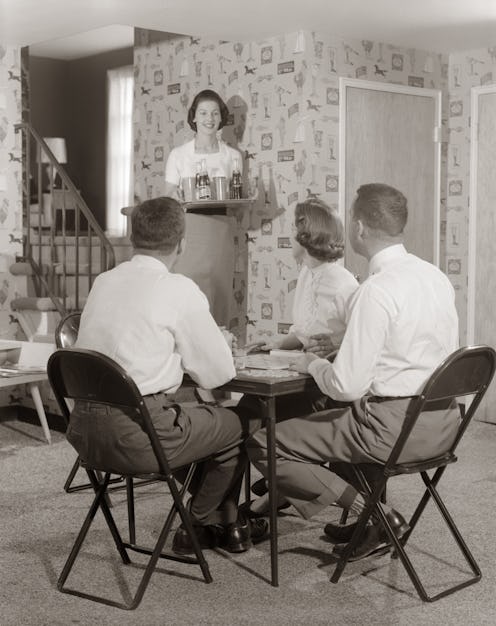Health
All Your Isolation Bubble Q’s, Answered
2020’s most exclusive club.

You may remember the Before Times, when you could hang out with whomever, whenever. Now, experts are suggesting people build "isolation bubbles" to keep each other safe from coronavirus while maintaining good social distancing practices. Isolation bubbles or pods containing family and friends might make life a lot easier: You avoid spreading COVID-19 while also having people around to challenge at Scrabble.
What Is An Isolation Bubble?
“An isolation bubble is a group of people such as a family or friend group who live together or very near each other," Dr. Teresa Bartlett, M.D., senior vice president and medical director at Sedgwick, a claims management service, tells Bustle. "They typically all agree that they will not interface with other people outside the group." It's kind of like an enclosed society: People in the bubble can interact with each other without anti-virus precautions (like masks), but have to be strict about social distancing, masks, and hand-washing with everybody else.
Why Isolation Bubbles Are Important
Isolation bubbles are meant to prevent any accidental spread of the coronavirus. "The virus has been reported to have an asymptomatic incubation period of up to 14 days by the Centers for Disease Control & Prevention (CDC)," epidemiologist Dr. Sadiya Khan, M.D., tells Bustle. Anybody could spread the virus without realizing that they have it, which is why keeping low your level of contact with people you don't live with is really crucial right now.
"The bubble is a very important concept for those with chronic diseases and high-risk populations," Bartlett says. "It's a way to have some level of family normalcy and yet protect against the virus." Bubbles can also help with research. Contact tracers — people who attempt to track where people with COVID-19 might have caught the virus — can use bubbles to trace cases. "If someone does get sick, that contact can be traced within the small bubble," Dr. Khan says.
What Are The Isolation Bubble Rules?
When it comes to the size of the bubble, experts agree that small is the way to go. “The bubble should contain all of the people who live in the home and may extend to other households as long as everyone adheres to the same set of rules," Bartlett says. "For example, households on the same block that contain extended family members are allowed to come and go from each other’s homes freely because they are all staying home and contained. Most importantly, they are only exposed to one another.” Meeting up with friends from far away or relatives who don't live in the area isn't encouraged.
The rules of a bubble have to be followed by everybody, experts say. People can only come in after at least 14 days of no symptoms, particularly if they've been exposed to people with COVID-19 recently, Khan says. Within the bubble, people can choose to interact freely — kissing, hugging, and chatting without masks — but when they go grocery shopping or out for other essential tasks, they have to observe strict social distancing and hygiene. Anybody showing symptoms of COVID-19, like a fever, cough, or loss of sense of smell or taste, needs to self-isolate away from their bubble immediately.
Can You Expand Your Isolation Bubble?
Organizing a bubble that involves more than one household can be tricky. Gideon Lichfield, editor-in-chief at MIT Technology Review, told NPR in May that the people in his isolation bubble, who live in multiple households, had an extensive conversation about the precautions every person was taking outside and inside, including mask-wearing, washing groceries, and meeting up with others. All the members of Lichfield's isolation bubble follow the same rules to attempt to reduce their risk of exposure to coronavirus and avoid conflicts.
Bubbles can change over time. "During the early phases of the pandemic, the 'isolation bubble' has been limited to your household, to limit spread," Khan says. You and your roommate, for instance, are your own isolation bubble. But you can allow more people in, depending on state and federal rules. In New Zealand the rules around isolation bubbles were relaxed over time; where at first it was just members of the same household, you can now "reconnect with close family or bring in caregivers, or support isolated people."
Interacting with people outside your bubble still carries big risks. According to data collected by the Georgia Institute of Technology, even the smallest indoor gatherings (10 people or under) in the least affected counties still might spread COVID-19.
Over time, Khan says, you can add more people to your bubble — but it shouldn't get too big. "We don’t want it to go to back to 'normal' in terms of large gatherings or more than 10 people, sporting events, or performances," she says. "The goal is still to try to contain spread by limiting contact to a slightly larger bubble."
Can You Venture Out Of Your Bubble For The Holidays?
No matter how much you miss singing Mariah Carey with your bestie, the holiday season is not the time to break your bubble. The U.S.'s coronavirus case count continues to rise, and no area of the country is completely without risk. Traveling in particular is discouraged. Instead, consider celebrating the holidays with people already inside your bubble.
If you're not already living in a bubble, now might be a good time to start — and don't expand it too quickly or too soon. "Bottom line, isolation bubbles (and masks) will save lives," Khan says.
Experts:
Dr. Teresa Bartlett, M.D., senior vice president and medical director at Sedgwick
Dr. Sadiya Khan, M.D., epidemiologist
This article was originally published on